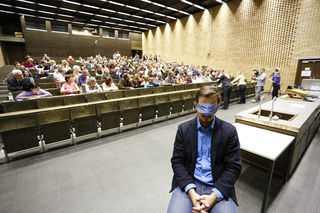Memory
How to Train Your Brain Like a Memory Champion
New research shows that an ancient technique strengthens brain connectivity.
Posted March 8, 2017 Reviewed by Jessica Schrader

You, too, can train your brain to become a memory athlete—one of those prodigious memorizers who compete to remember the longest sequence of playing cards, or put the most names to faces in the least amount of time. To perform such cognitive feats, memory athletes rely on an ancient mnemonic strategy called method of loci (Latin for places) or memory palace, the term Joshua Foer used in his popular book on memory champions, Moonwalking with Einstein. A new study published this week in Neuron compares, for the first time, the brains of memory athletes to those of regular folks given six weeks of training in the method of loci system. The non-athletes not only achieved similar feats of memory, but they also exhibited the same brain changes seen in the memory athletes with much stronger functional connectivity across relevant networks.
The study was a collaboration between the Donders Institute for Brain, Cognition and Behavior in the Netherlands and the lab of Dr. Michael Greicius of Stanford University School of Medicine. Researchers scanned the brains of 23 memory athletes and 51 controls who had never memorized anything out of the ordinary, but were evenly matched with the athletes in all other respects, including IQ. Controls were then randomly assigned to method of loci training, a working memory task, or no training at all, and rescanned.
Before and after training, the controls were given 72 words to memorize. The method of loci group more than doubled the number of words they remembered—from a mean of around 30, they increased by an average of 35 words. Many got all or close to 72 words. And the pattern of functional connectivity in their brains changed to look more like the memory athletes as well. Networks handling visuospatial and memory processing bulked up and were more tightly linked. The other two control groups didn’t see a significant change in either their memories or their brains. Even four months later, the loci group showed improved recall, while the others did not.
I asked one of the lead authors, Martin Dresler of the Donders Institute, about the method of loci and what the study might mean for run-of-the-mill glasses-losing, name-forgetting humans.
How does the method of loci work?
It's been used for thousands of years. You use spatial or environmental cues to help learning and memory. Most memory athletes use a route, through their house or from home to work, and identify salient landmarks. To memorize their shopping list, they might imagine stuffing bread in the mailbox. At the first traffic light, they imagine green or red apples instead of green or red lights. When they want to retrieve the information, they mentally re-travel the route and pick up the information.
Memory athletes insist they, too, lose their keys. Really?
They all say they didn’t have particularly good memories at birth, but they trained in these mnemonic strategies. It’s a strategic kind of memory you apply. If you learn the strategy, but don’t use it, you aren’t any better than before. You have to apply it when putting the keys somewhere, or you’re just as likely to lose them.
Why does the method work so well?
Probably because our brains didn’t evolve to memorize or learn abstract information, they evolved to learn the way to the next food source or where to meet our mating partners. The method of loci makes use of these evolved skills to find your way through the environment, to know where in space certain locations are hidden and what is associated with each space.

Have you tried it?
One of my co-authors, Boris Konrad, has been a memory athlete for many years, quite a successful one. He always tries to get me to use these memory techniques. When I do, I’m capable of memorizing the first 100 digits of Pi or something like that, but mostly I’m just too lazy. To really become good at it, you have to invest in some training.
What did we know about the brains of memory athletes before this study?
Very little. One landmark paper about 12 years ago put eight athletes in the scanner. The brains were completely normal [with no] anatomical or structural differences. But [while memorizing], spatial and visual areas were more activated compared to controls.
And what did you find?
We looked at functional connectivity [or how tightly linked brain areas are] between and within those networks. The more similar a training participant became on the neural level with the memory athletes, the better he was after training.
Can people try this at home?
We used an online training platform in the study called Memocamp, but most of the memory athletes googled the method and started that way. Many of them do not train super-regularly. A few weeks before a memory championship, they start to train half an hour a day or so, but then maybe they don’t train for a half a year. With this technique, even at a low baseline, you can strongly improve your memory.
References
Dresler et al., "Mnemonic Training Reshapes Brain Networks to Support Superior Memory." Neuron 93, (2017): 1-9.
Maguire, Eleanor A., et al. "Routes to remembering: the brains behind superior memory." Nature neuroscience 6.1 (2003): 90-95.


